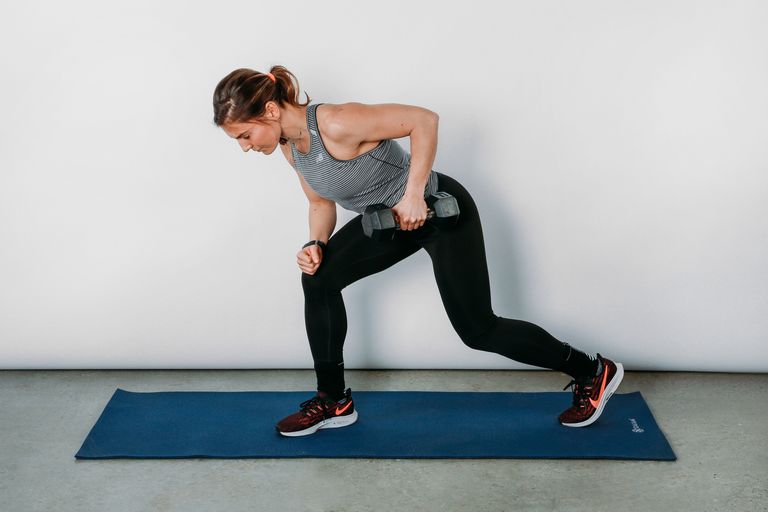Runners’ legs hog all the attention—which OK, fair: Your quads, glutes, calves, and hamstrings seem to be doing the majority of the work in moving you forward. But when it comes to your running performance, there’s a major muscle group you’re probably neglecting, and they’re actually in your upper body. It’s your latissimus dorsi, or your lats, and incorporating lat exercises into your training can actually help you on your way to a PR. Here’s why.
Your latissimus dorsi (which extends from the bottom of your shoulder blades to the top of your glutes) is the largest muscle in your upper body, and it should be working hard while you’re running. “The main role of the lats during running is to work alongside your abs and core to create rotational force and keep your torso upright,” explains Ben Lauder-Dykes, a NASM-certified trainer at Fhitting Room in NYC.
RELATED: 4 Gym-Free Ab Workouts You Can Do In 5 Minutes!
Think about how your hips and shoulders rotate in opposite directions when you run. That twisting motion helps absorb and release energy, sort of like how a coil tightens and then springs loose. The stronger your lats are, the more they help with that rotation, which helps you not just run more efficiently, but also tap into more running power so you can faster and longer.
RELATED: Power Your Running With This Back & Biceps Workout
“Your lats help keep your torso upright, with your head stacked over the rib cage and rib cage stacked over the hips; in this position, your foot will likely land underneath you, where it’s supposed to,” says Lauder-Dykes. If your lats are too weak or not engaged, “then your forward arm swing pulls your head in front of the pelvis, which forces the foot to land too far in front, which can place too much stress on the hamstrings, creating a lot more work for you and increasing your risk of injury.”
You know running is a total-body sport. And being an efficient runner is all about maximizing as much of your effort as possible. “If you’re lacking upper body strength and core control, the lower body has to work harder and you will lose some of the force generated from the legs as you run,” says Lauder-Dykes. And isn’t that just a kick in the face to all the other training you’re doing?
RELATED: 6 Core Stability Exercises For Stronger Running
Get your lats in gear with these targeted exercises from Lauder-Dykes.
How to use this list: Incorporate 2 to 3 of these exercises into your cross-training schedule and perform for the number of reps and sets indicated. Each move is demonstrated by Jess Movold, Runner’s World coach, so you can learn the perfect form. You will need a dumbbell and/or a kettlebell and a resistance band with handles.
1. Single-Arm Dumbbell Row
Start in a high lunge position with left foot back and dumbbell in left hand. Hinge at hips, keeping a soft bend in both knees, and place right forearm across right leg for support so shoulders, chest, and hips are parallel to the floor. From a fully extended position, drive elbow of working arm toward hip to pull the dumbbell up toward the chest. Hold for two seconds, then slowly lower back down. Do 3 sets of 8 to 10 reps with each arm.
2. Kettlebell Rack Hold
Clean either a single kettlebell into a racked position (hand may rest slightly inside the shoulder, but elbows should always be tight to the body). Actively pull the elbow down to the hip to engage lats and pull shoulders away from ears; you should feel your hand and the bell pressing into your chest. Resist leaning back by focusing on pulling the hips back, which will bring the shoulders forward. Engage your core, and focus on pressing your feet into the floor. Do 2 to 3 sets holding for 20 to 45 seconds.
3. Seated Sprinter Arm Swing With Resistance Band
Sit with legs extended straight in front of you, chest tall, and shoulders back, holding the handle of a resistance band that’s anchored to a wall in each hand at chest height. Start swinging arms back and forth, mimicking the form of an arm swing while sprinting, alternating arms for 10 seconds. Rest for 50 seconds, then repeat for 4 to 6 sets total.
4. Lat Pull-Down
Anchor a resistance band with handles above your head or sit at a lat-pulldown machine. Grab the handles or bar with an underhand grip (to increase range of motion and better mimic the arm swing action during running), hands shoulder-width apart, arms straight, and torso upright. Pull the elbows toward the hips, keeping the shoulders down and away from the ears. Pause, then slowly return to start. Do 2 to 4 sets of 6 to 8 reps.
5. Renegade Row
Start in a high plank position with hands on two dumbbells, wrists under shoulders, core engaged so body forms a straight line from head to heels and feet in a wide stance. Engage back to slowly pull right hand and dumbbell up to the rib cage, then slowly return the weight to the floor. Repeat on left side side. Continue alternating. Do 3 sets of 8 to 10 reps with each arm.
6. Plank Pull-Through
Start in a high plank position with wrists under shoulders, core engaged so body forms a straight line from head to heels and place a dumbbell near right hand. Shift weight to left side of body, then reach right hand underneath and across to grab the weight and drag it until it’s under the right palm. Return right palm to floor, grab weight with left hand, and pull left for one rep. Do 3 sets of 8 to 10 reps.
7. Chin-Up
Hang from a pull-up bar with an underhand (chin-up) grip, hands about shoulder-width apart. Keeping your core tight, bend at the elbows and shoulders and pull your chest to the bar. Pause, then lower with control. (For assistance, throw a long resistance band around the bar and pull one end through the other end to secure, then place feet on the bottom loop.) Do 3 sets of 8 to 10 reps.
All images: Julia Hembree Smith

